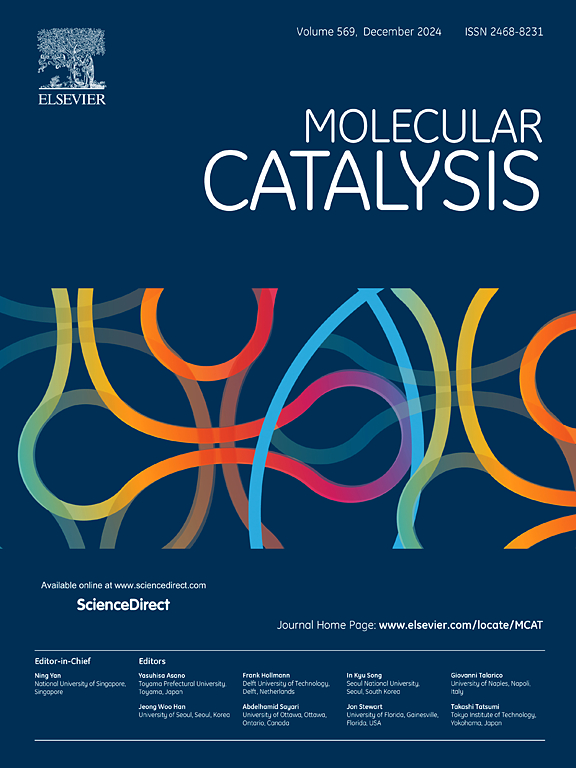评价各种金属氧化物在木质素解聚中的催化性能:以Bi2O3用于生物油生产为重点
IF 4.9
2区 化学
Q2 CHEMISTRY, PHYSICAL
引用次数: 0
摘要
木质素催化氢解制备高附加值化学品是近年来研究的热点。采用共沉淀法制备了金属氧化物催化剂。Bi₂O₃在催化木质素解聚以生产生物油方面表现出独特的优势,在木质素结构内的醚键裂解方面表现出高选择性。本研究的目的是比较金属铋与其他几种金属催化氢解木质素的性能。基于响应面法(RSM),确定了几种金属氧化物在最佳条件下对木质素制备生物油的催化性能:NiO (77.18 wt %)≈Bi₂O₃(77.04 wt %) >;Co₃O₄(71.12 wt %) >;CeO₂(61.39 wt %);然而,用更少的Bi₂O₃催化剂也能达到类似的性能。气相色谱-质谱(GC-MS)分析表明,Bi₂O₃催化产物的酚类化合物收率为66.45 wt %,显著高于其他金属氧化物催化产物。值得注意的是,甲酚(G2)和香兰素(G3)的总收率达到21.36 wt %,是所有催化剂中最高的。扫描电镜(SEM)和傅里叶变换红外光谱(FTIR)分析表明,在Bi₂O₃催化剂的作用下,木质素解聚体系中的组分分布均匀,有利于醚键的断裂,促进了大量酚类化合物的生成。分析了温度、时间和催化剂用量对木质素催化氢解反应的交互作用,以及氢供体甲酸的加入对解聚反应的影响。最后,回收率测试表明,连续5次回收后,Bi₂O₃的催化性能仍然保持活跃和稳定。本文章由计算机程序翻译,如有差异,请以英文原文为准。

Evaluating the catalytic performance of various metal oxides in lignin depolymerization: Focus on Bi2O3 for bio-oil production
Catalytic hydrogenolysis of lignin to high value-added chemicals has been a hot topic in recent years. Metal oxide catalysts are prepared by the co-precipitation method. Bi₂O₃ exhibits unique advantages in catalyzing lignin depolymerization for bio-oil production, demonstrating high selectivity in cleaving ether bonds within the lignin structure.The purpose of this study is to compare the performance of bismuth metal with several other metals for the catalytic hydrogenolysis of lignin. Based on the response surface methodology (RSM), the catalytic abilities of several metal oxides for the preparation of bio-oil from lignin under optimal conditions were determined as follows: NiO (77.18 wt %) ≈ Bi₂O₃ (77.04 wt %) > Co₃O₄ (71.12 wt %) > CeO₂ (61.39 wt %); However, comparable performance can be achieved with significantly lower amounts of Bi₂O₃ catalysts. Gas chromatography-mass spectrometry (GC–MS) analysis demonstrated that Bi₂O₃-catalyzed product contained 66.45 wt % yield of phenolic compounds, significantly higher than those catalyzed by other metal oxides. Notably, the combined yield of creosol (G2) and vanillin (G3) reached 21.36 wt %, representing the highest value among all catalysts tested. Scanning electron microscopy (SEM) and Fourier transform infrared spectroscopy (FTIR) spectra showed that the components in the lignin depolymerization system were uniformly dispersed in the presence of Bi₂O₃ catalyst, which contributed to the cleavage of ether bonds and promoted the generation of a large amount of phenolic compounds. The interactive effects of temperature, time and catalyst dosage on the catalytic hydrogenolysis of lignin and the effect of the addition of the hydrogen donor, formic acid, on the depolymerization were also analyzed. Finally, the recoverability test showed that the catalytic performance of Bi₂O₃ remained active and stable after five consecutive recovery runs.
求助全文
通过发布文献求助,成功后即可免费获取论文全文。
去求助
来源期刊

Molecular Catalysis
Chemical Engineering-Process Chemistry and Technology
CiteScore
6.90
自引率
10.90%
发文量
700
审稿时长
40 days
期刊介绍:
Molecular Catalysis publishes full papers that are original, rigorous, and scholarly contributions examining the molecular and atomic aspects of catalytic activation and reaction mechanisms. The fields covered are:
Heterogeneous catalysis including immobilized molecular catalysts
Homogeneous catalysis including organocatalysis, organometallic catalysis and biocatalysis
Photo- and electrochemistry
Theoretical aspects of catalysis analyzed by computational methods
 求助内容:
求助内容: 应助结果提醒方式:
应助结果提醒方式:


